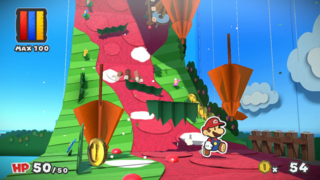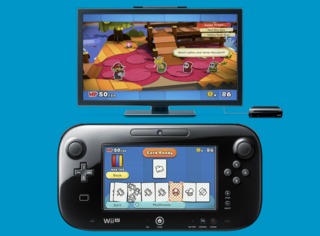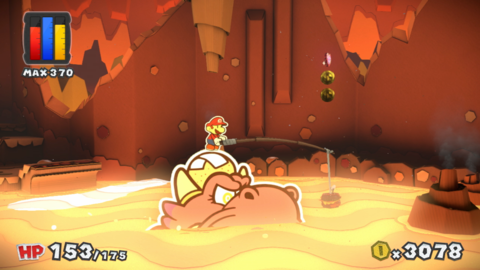Rather than have two concurrent Mario RPG series, Nintendo has kept most of that genre’s trappings confined to the Mario & Luigi series for over a decade. Paper Mario may have taken the torch from Super Mario RPG with its first two entries, but later titles strayed further and further from the formula. Super Paper Mario was a platformer for all intents and purposes, and Sticker Star took a different approach altogether. The 3DS title eliminated XP and leveling, severely handicapping any sense of progression. In addition, combat was regulated by a finite collection of stickers that Mario would collect in the world. As polarizing as Sticker Star was for fans of the series, Paper Mario: Color Splash doubles down on its most frustrating elements and makes them even worse.

What makes Color Splash such a tremendous disappointment is the fact that so much of it is great. Throughout the game’s lengthy story, it consistently made me laugh with its clever writing and numerous nods to Mario history. Prism Island plays host to a wide variety of locations and activities, and I was always curious what the game would be having me do next. Restoring color to the world is Mario’s goal, and doing so tasks him with appearing on a game show, assembling a train, organizing a tea party at a haunted hotel, and a ton more. It even manages to sneak in some great parodies and references that rarely seem forced.
Just about everything in Color Splash is instantly likable except for the thing that you spend the most time doing. Each time I encountered an enemy, it felt like a punch to the gut. I’d often be walking around, admiring the game’s gorgeous visuals and wondering what it would be having me do next. Then, I’d encounter an area filled with enemies and I’d be reminded of how thoroughly Nintendo dropped the ball with this game.
Numerous things are terrible about the combat system, and any one of them is bad enough to bring down the quality of the game as a whole. Together, they have the ability to make the experience miserable at times.
Like Sticker Star, combat is regulated by single-use cards that Mario can buy or find in the environment. Since there isn’t any kind of infinite base level attack that can be pulled out at any point, I was frequently required to waste powerful cards on enemies that were already near death. This system can back you into a corner. If you’ve run out of hammers and all you have are a bunch of jump cards, good luck trying to take out that Shy Guy with a spiked helmet on his head.
Oftentimes, powerful cards will just be taken from you without warning. At random points, Kamek will fly by at the beginning of standard battles and turn all of your cards over. You’re forced to blindly choose cards to play, meaning that you could easily waste one of your most powerful attacks on a weak enemy. Some fights even feature enemies that hop onto the playing field and eat your cards before you have a chance to use them.

This is especially infuriating if it’s a Thing card. These are special cards that transform the battlefield into a photorealistic environment, and often do massive damage to your enemies. More often than not, these rare items are required to finish off a boss or advance the story. If you lose it in one of several random ways, you’re forced to exit the area you’re in and head back to the main hub world to buy another.
As boneheaded as the entirety of the combat system is, it’s made even worse thanks to the method in which you attack. It’s insane that GamePad functionality has been so clumsily incorporated this late in the Wii U’s lifecycle. Each time you want to attack, you have to scroll through a giant deck of cards on the GamePad screen with the stylus. You then slide the cards that you want to use up to the top of the screen. Once your cards are in place, you confirm that they are the cards that you wish to attack with. The GamePad takes you to another screen that has you tap and hold on each individual card to determine how much paint you want to put into them (paint increases attack damage). When your paint levels are where you want them to be, you hit confirm again. At the next screen, you flick the cards up with the stylus to actually attack. This song and dance happens every single time that it’s your turn during combat. There is an option in the settings menu that allows you to eliminate one of the “confirm” screens, but the process remains painfully slow.

This is all the more maddening when you realize how fruitless combat is to begin with. Sticker Star’s dumbed-down progression system is even more severely neutered in Color Splash. Mario can expand his paint reserves by collecting hammers after fights, and his HP goes up by 25 at six predetermined points in the story. Outside of a few upgrades that increase the number of cards that Mario can play in one turn, there is nothing else that you can do to feel more powerful.
Let’s break this down. You fight by playing single-use cards. If you win, you’re rewarded with coins. You use coins to...buy more cards. With that system in place, why would anyone ever want to encounter an enemy in the field? I never once felt like any of the standard fights were doing anything to progress the story or my character’s abilities. It’s maddening. I got to a point in which I started trying to flee from every fight. This works on occasion, but it’s terrible when Mario falls flat on his face while attempting to flee and you’re forced to go through another awful round of card-based combat.
There are other unfortunate elements in play that aren’t tied to the combat. Several stages require you to play through their entirety two or more times. At five different points in the story, progress is halted unless you’ve found an entire “rescue squad” of Toads that are spread throughout the world. It’s discouraging to think that you’re about to enter a new area, only to be told that you can’t continue without finding five or six Toads that are hiding in unspecified locations in previous levels.

I changed my tune on one of my favorite areas by the end of it. The haunted hotel isn’t combat-heavy, and focuses more on puzzle solving. I enjoyed trying to hunt down a collection of Toad ghosts so that they could organize a tea party. This area has several clever puzzles, and the reduced focus on combat was really helping me spend time with the things I liked about the game. When I was down to the last Toad that I had to collect, a grandfather clock rang and I was met with a game over screen. It had failed to adequately explain to me that there was a time limit for this area, and I was forced to start over from the beginning.
Even the sidequests feel useless. The biggest one involves temples in which you compete in rock-paper-scissors. Your prize for winning? Coins that you use to buy cards, and cards that you use to win fights that give you coins.
Every level has blank spots for Mario to fill in with paint. I initially enjoyed this side activity and shot for 100-percent “colorization” on every stage. This pursuit stopped once I realized that a character called the Shy Bandit pops up randomly to suck the color out of levels with a straw. If you don’t catch him in time on the world map, your 100-percent colorization can go down to next to nothing. Even if you do get full colorization in an area, your reward is just unlockable music tracks.

Often, the method to advance the story will be completely unclear. Your talking paint can named Huey is supposed to help point you in the right direction if you press up on the d-pad, but he frequently has no advice beyond “Hey, maybe you should talk to some Toads around town!”
That’s never hard to do, because everything is a goddamn Toad in this game. Previous Paper Mario games have featured a wide variety of NPCs, complete with tons of different looks and personalities. In Color Splash, it’s just a bunch of Toads of different colors. Sometimes they’ll have scarves. A couple of them had pirate hats. In the end, they’re all just Toads. Oh, you need to climb a mountain to talk to a wise old sage? Just a Toad. He doesn’t even have a beard. Ghosts are all over this hotel? They’re just Toads with an aura effect around them. I think one of them had glasses.
I can’t remember the last time I’ve been so thoroughly divided on a game. One part of me loves it. It’s genuinely funny, and the writing and locations are fantastic. Prism Island is gorgeous, and the soundtrack meets the high bar of quality that Mario games are known for. In the end, though, I spent most of this game trying to avoid playing the biggest part of it. Every combat encounter reminds you of how broken a critical element of the game is, and they happen frequently. It’s staggering how much this one system routinely destroyed my enthusiasm for the game.
With more traditional RPG mechanics and a real progression system, Paper Mario: Color Splash could have been one of the best games in the series. Because of some unfathomably ill-conceived decisions during the development process, it’s one of the very worst.
